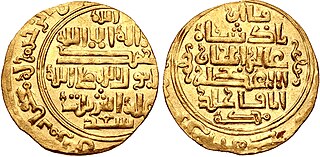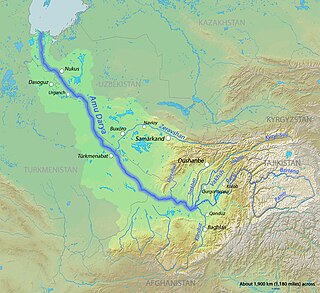Related Research Articles

Tajikistan harkens to the Samanid Empire (819–999). The Tajik people came under Russian rule in the 1860s. The Basmachi revolt broke out in the wake of the Russian Revolution of 1917 and was quelled in the early 1920s during the Russian Civil War. In 1924, Tajikistan became an Autonomous Soviet Socialist Republic of the Soviet Union, the Tajik ASSR, within Uzbekistan. In 1929, Tajikistan was made one of the component republics of the Soviet Union – Tajik Soviet Socialist Republic – and it kept that status until gaining independence 1991 after the dissolution of the Soviet Union.

Bukhara is the seventh-largest city in Uzbekistan by population, with 280,187 residents as of 1 January 2020. It is the capital of Bukhara Region.

Raziyyat-Ud-Dunya Wa Ud-Din, popularly known as Razia Sultana, was a ruler of the Delhi Sultanate in the northern part of the Indian subcontinent. She was the first female Muslim ruler of the subcontinent, and the only female Muslim ruler of Delhi.

Shams ud-Din Iltutmish (Persian: شمس الدین ایلتتمش; was the third of the Mamluk kings who ruled the former Ghurid territories in northern India. He was the first Muslim sovereign to rule from Delhi, and is thus considered the effective founder of the Delhi Sultanate.
Khatun is a title of the female counterpart to a khan or a khagan of the Turkic Khaganates and in the subsequent Mongol Empire.

Barno Iskhakova was a Soviet and Bukharian Jewish musician from Tajikistan.
Abū Ḥafṣ Qutayba ibn Abī Ṣāliḥ Muslim ibn ʿAmr al-Bāhilī was an Arab commander of the Umayyad Caliphate who became governor of Khurasan and distinguished himself in the conquest of Transoxiana during the reign of al-Walid I (705–715). A capable soldier and administrator, he consolidated Muslim rule in the area and expanded the Caliphate's border to include most of Transoxiana. From 705 to c. 710, he consolidated Muslim control over the native principalities of Tokharistan and conquered the principality of Bukhara, while in 710–712 he conquered Khwarizm and completed the conquest of Sogdiana with the capture of Samarkand. The latter opened the road to the Jaxartes valley, and during the last years of his life Qutayba led annual campaigns there, extending Muslim control up to the Fergana Valley and parts of Chinese Turkestan.
The history of Bukhara stretches back millennia. The origin of its inhabitants goes back to the period of Aryan immigration into the region. The city itself, currently the capital of the Bukhara Region (viloyat) of Uzbekistan, is about two and a half thousand years old. Located on the Silk Road, the city has long been a centre of trade, scholarship, culture, and religion. During the Golden age of Islam, under the rule of Samanids, Bukhara became the intellectual centre of the Islamic world. In medieval times, Bukhara served as the capital of the Khanate of Bukhara and was the birthplace of Imam Bukhari.

Abdurauf Fitrat was an Uzbek author, journalist, politician and public intellectual in Central Asia under Russian and Soviet rule.

The Muslim conquest of Transoxiana, also called the Arab conquest of Transoxiana, was part of the early Muslim conquests. It began shortly after the Muslim conquest of Persia enabled the Arabs to enter Central Asia. Relatively small-scale incursions had taken place under the Rashidun Caliphate, but it was not until after the establishment of the Umayyad Caliphate that an organized military effort was made to conquer Transoxiana, a region that today includes all or parts of Uzbekistan, Tajikistan, Kazakhstan, and Kyrgyzstan. The campaign continued under the Abbasid Caliphate, and gradually saw the Islamization and Arabization of the region, which has been predominantly inhabited by Turkic peoples.

Abish Khatun — was the 9th and last ruler of the Salghurids of Shiraz from 1264 to 1284.
The Bukhar Khudahs or Bukhar Khudats were a local Sogdian dynasty, which ruled the city of Bukhara from an unknown date to the reign of the Samanid ruler Isma'il ibn Ahmad, who incorporated Bukhara into the Samanid state.

Slavery in Afghanistan was present in the post-Classical history of Afghanistan, continued during the Middle Ages, and persisted into the 1920s.
Tughshada was Bukhar Khudah from 681 to 739. He was the son and successor of Bindu.
Sa'id ibn Uthman ibn Affan al-Umawi was an Umayyad general and military governor of Khurasan in 676–677 during the reign of Caliph Mu'awiya I. He was a son of Caliph Uthman and a one-time seeker of the caliphate in 675/76.

Chattel slavery was a major part of society, culture and economy in the Abbasid Caliphate (750–1258), which during its history included most of the Middle East. While slavery was an important part also of the preceding practice of the Umayyad Caliphate (661–750), it was during the Abbasid Caliphate that the slave trade to the Muslim world reached a more permanent commercial industrial scale, establishing commercial slave trade routes that were to remain for centuries.

Slavery in the Umayyad Caliphate refers to the chattel slavery taking place in the Umayyad Caliphate (661–750), which comprised the majority of the Middle East with a center in the capital of Damascus in Syria.

The Bukhara slave trade refers to the historical slave trade conducted in the city of Bukhara in Central Asia from antiquity until the 19th century. Bukhara and nearby Khiva were known as the major centers of slave trade in Central Asia for centuries until the completion of the Russian conquest of Central Asia in the late 19th century.

The Gurgānj Dam was a major water engineering project of medieval-era Central Asia. The dam was constructed on the Amu Darya (Oxus) river, near what is now called Konye-Urgench in northern Turkmenistan. It was destroyed in 1221 by the troops of Genghis Khan and began to flow into Sarygamysh Lake.

The slave trade in the Mongol Empire refers to the slave trade conducted by the Mongol Empire (1206–1368). This includes the Mongolia vassal khanates which was a part of the Mongol Empire, such as the Chagatai Khanate (1227–1347), Yuan dynasty (1271–1368), Ilkhanate (1256–1335), and Golden Horde (1242–1368).
References
- ↑ Bowersock, G. W., Brown, P., Grabar, O. (1999). Late Antiquity: A Guide to the Postclassical World. Storbritannien: Belknap Press of Harvard University Press. 702
- ↑ Ayni, S. (2023). Tajikistan's National Epics: Muqanna's Rebellion and The Tajik People's Hero Temur Malik. Storbritannien: Taylor & Francis.
- ↑ Living Islamic History: Studies in Honour of Professor Carole Hillenbrand. (2010). Storbritannien: Edinburgh University Press. 83
- 1 2 3 The Oxford Handbook of Iranian History. (2012). Storbritannien: Oxford University Press, USA. 218
- ↑ Ayni, S. (2023). Tajikistan's National Epics: Muqanna's Rebellion and The Tajik People's Hero Temur Malik. Storbritannien: Taylor & Francis.
- ↑ Naršaḵī, pp. 54, 56-57, tr. pp. 40-41; cf. H. A. R. Gibb, The Arab Conquests in Central Asia, London, 1923, pp. 19-20
- ↑ BARDA and BARDA-DĀRI iii. In the Islamic period up to the Mongol invasion in Encyclopedia Iranica
- ↑ Ayni, S. (2023). Tajikistan's National Epics: Muqanna's Rebellion and The Tajik People's Hero Temur Malik. Storbritannien: Taylor & Francis.